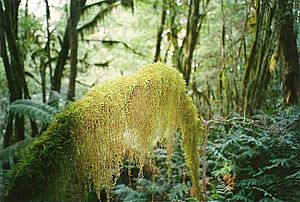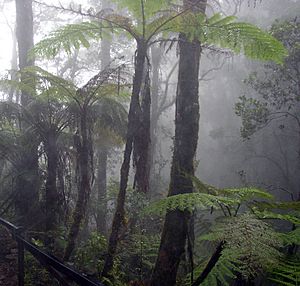Cloud forest facts for kids
A cloud forest (also called a fog forest) is a special kind of forest, usually found in warm, wet places near the Tropics or Subtropics. These forests are always green and grow on mountains. What makes them unique is that they are often covered in low-lying clouds or fog, especially around the tops of the trees.
In these forests, you'll often see lots of mosses covering the ground and trees. This is why they are sometimes called mossy forests. They usually grow in mountain areas where moisture from clouds gets trapped.
Cloud forests can be found at different heights, from about 500 meters (1,640 feet) to 4,000 meters (13,120 feet) above sea level. The constant fog at tree level helps to block direct Sunlight, which keeps the forest cool and moist. A lot of the water for the plants comes from "fog drip." This happens when tiny water droplets from the fog stick to leaves and branches, then join together into bigger drops that fall to the ground.
These amazing forests are quite rare. Only about 1% of all the woodlands on Earth are cloud forests. You can find important cloud forest areas in Central and South America, parts of Africa (East and Central), Indonesia, Malaysia, the Philippines, Papua New Guinea, and the Caribbean islands.
What makes them special?

Compared to other tropical forests found at lower heights, cloud forests have some unique features. The trees here are usually shorter and have thicker trunks. They often have twisted branches and dense, compact tops.
One very important thing about cloud forests is how the tree tops catch moisture from the clouds. This is called fog drip. It happens when water droplets from the fog stick to the leaves or needles of trees. These small drops then combine into larger ones and fall to the ground. Fog drip can add a lot of water to the Water cycle in these areas.
The soil in cloud forests is usually very wet. There's also less Sunlight reaching the ground, and dead plants and animals break down very slowly. This means the soil is often very acidic, with a thick layer of humus and peat on top.
Why are they in danger?
In 1970, there were about 50 million hectares of cloud forests around the world. Sadly, a lot of these forests have been lost. Things like a growing population, poverty, and uncontrolled use of land have all played a part. A study in 1990 found that 1.1% of tropical mountain forests were lost each year. This was a higher rate than any other type of tropical forest.
The good news is that efforts are being made to protect them. By 2004, about one-third of all cloud forests on the planet were officially protected.
Images for kids
-
One of the hanging bridges of the Sky walk at the Monteverde Cloud Forest Reserve in Monteverde, Costa Rica disappearing into the clouds
-
Bryophyte-covered mossy forest at Mount Dulang-dulang, Philippines
-
Temperate cloud forest on La Palma, Canary Islands
-
At the edge of the Panamanian side of the Parque Internacional la Amistad
-
Seaborne moisture is vital to the cloud forest of Fray Jorge that is surrounded by the arid southern reaches of the Atacama Desert.
See also
 In Spanish: Bosque nuboso para niños
In Spanish: Bosque nuboso para niños








